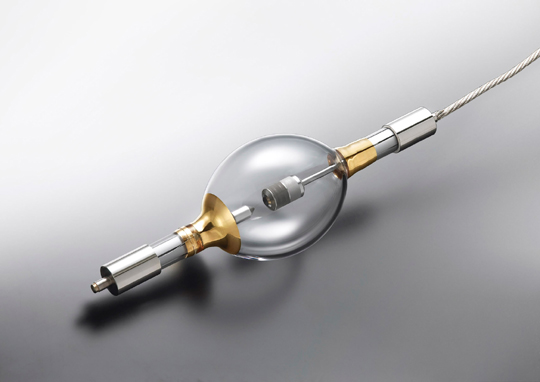Introducing the World’s First Full and Half Lighting System, an Environmental Technology for Super High-Pressure UV Lamps
Reducing power consumption and CO2 emissions by 40%
USHIO INC. (headquartered in Tokyo; Shiro Sugata, President and CEO; “USHIO”) is pleased to announce that it is the first company in the world(*1) to have successfully implemented the Full and Half Lighting System, an environmental technology for Super high-pressure UV lamps.(*2)
Super high-pressure UV lamps are utilized as light sources for lithography (circuit pattern printing) in exposure systems, mainly for semiconductors, liquid crystal, and printed circuit board. A key business focus in these industries has been reducing the environmental load.(*3) To meet this demand, lamp manufacturers have sought to conserve power and reduce CO2 emissions to enhance the environmental performance of lamps.
For exposure systems, however, the power input has to be maintained at 100% at all times, even during standby when the objects are not required being irradiated. This is due to the structural properties and to maintain performance in terms of lighting intensity, luminance, service life and other factors. It has been extremely difficult to make improvements in this area.(*4)
The Full and Half Lighting System that USHIO has successfully implemented is a lighting technology that allows the power input to be switched in two steps, without adversely affecting the performance of the super high-pressure UV lamps required for exposure. The power is maintained at 100% only when objects are exposured by UV light, at other times at 50%. Super high-pressure UV lamps utilizing the Full and Half Lighting System environmental technology enable power consumption and CO2 emissions to be reduced by 40% compared to conventional lamps.(*5)
In the case of a production line using 20 super high-pressure UV lamps of 25kW each, for example, power consumption is able to be reduced by around 2,040,000kWh per year (around 26.4 million yen per year in electricity charges), and CO2 emissions can be cut by around 780 tons.(*6)
In addition, the total amount of heat dissipation by the lamps is also reduced, which facilitates the size reduction of exposure systems and chiller units. This can potentially lead to an even greater reduction in overall costs.
As part of its medium-term administrative vision, USHIO has been focusing on developing and offering products that help reduce the environmental load. Under its unique environmental policies(*7), USHIO has developed technologies and products that satisfy both environmental performance and the required product performance. USHIO is concentrating on proceeding steadily with the development of these technologies and products, while at the same time furthering its contributions to the environment.
|
*1:As of the end of September 2010; surveyed by our company. *2:USHIO has been manufacturing and selling various types of super high-pressure UV lamps for over 40 years, and its global share of these lamps for use with semiconductors, liquid crystal and electronic component production is around 75% (as of the end of September 2010; surveyed by our company). *3:At the production sites for these products, the power consumption of the manufacturing devices has been increased to improve yields and productivity. Particularly in terms of the manufacture of liquid crystal panels, the exposure area has continued to grow due to the increased sizes of the panels being manufactured. To manage this situation, super high-pressure UV lamps have also seen trends toward greater output and use in groups. As a result, the total environmental load of exposure devices has continued to increase each year. *4:With conventional super high-pressure UV lamps, the power input is traditionally maintained at a constant level of 100% to avoid a decline in lighting intensity and service life that accompany output switching. UV light is irradiated onto objects by opening and closing the shutter between the lamp and the object to be irradiated. For this reason, power consumption and CO2 emissions occur even when the shutter is closed (on standby), when no irradiation is necessary to take place. *5:As of the end of September 2010; compared to our conventional products; surveyed by our company. *6:See the Environmental Data below for details. *7:See the following website for details on the environmental measures undertaken by USHIO(http://www.ushio.co.jp/en/csr/) |
Product development
Sales of super high-pressure UV lamps utilizing the Full and Half Lighting System environmental technology will commence in April 2011 for large output (25kW) lamps used in FPD exposure, for which the greatest environmental impact is anticipated. Thereafter, products for other applications will be developed successively.

25kW super high-pressure UV lamps utilizing the Full and Half Lighting System
Environmental Data
| Lighting method |
Full and half lighting*8 |
Constant lighting (conventional lamps) |
|---|---|---|
| Power consumption*9 |
Approx. 152,000 kWh/year |
Approx. 254,000 kWh/year |
| Electricity charges*10 |
Approx. 1.98 million yen/year |
Approx. 3.3 million yen/year |
| CO2emissions*11 |
Approx. 57 tons/year |
Approx. 96 tons/year |
| Wavelengths of emitted light |
436nm, 405nm, 365nm, 313nm |
|
| Guaranteed service life |
750 hours |
|
| Relative lighting intensity |
1.0 |
|
| Major applications |
Light source for liquid crystal pattern formation, light source for color filter pattern formation, light source for plasma display pattern formation, light source for printed circuit board formation, other new exposure applications |
|
|
*8:Calculated assuming the rated output at times of exposure (2 sec), and half that of the rated output when not used for exposure (6 sec), with the time to process one sheet being 60 seconds in six shots. *9:24 hours x 30 days x 12 months x amount of power consumption when one 25kW lamp is used. *10:Calculated assuming the charge to be 13 yen per kWh. *11:Calculated assuming the emissions to be 0.378kg-CO2 per kWh. |
